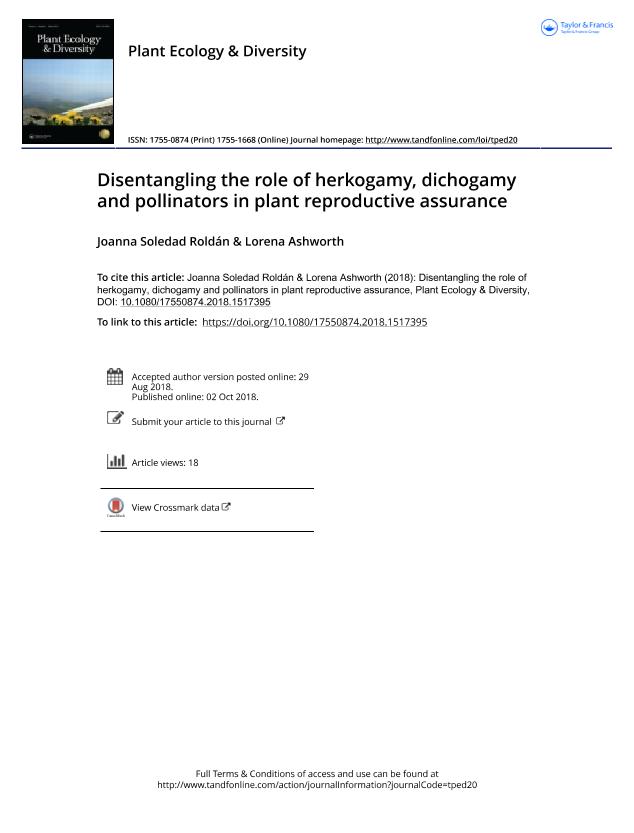Mostrar el registro sencillo del ítem
dc.contributor.author
Roldán, Joanna Soledad

dc.contributor.author
Ashworth, Lorena

dc.date.available
2019-11-04T16:54:06Z
dc.date.issued
2018-05
dc.identifier.citation
Roldán, Joanna Soledad; Ashworth, Lorena; Disentangling the role of herkogamy, dichogamy and pollinators in plant reproductive assurance; Taylor & Francis Ltd; Plant Ecology & Diversity; 11; 3; 5-2018; 383-392
dc.identifier.issn
1755-0874
dc.identifier.uri
http://hdl.handle.net/11336/87901
dc.description.abstract
Autonomous selfing can be favoured by reduced floral herkogamy, dichogamy and pollinator visitation. Autonomous selfing diminishes as pollinator abundance increases; however, the ways pollinators contribute to such result have not been tested. Pollinators can reduce the occurrence of autonomous selfing by two not mutually exclusive mechanisms: successful pollen deposition on stigmas and pollen removal from anthers. Aims: We tested the role of herkogamy and protandry on autonomous selfing and the role of pollinators to reduce it via pollen removal. Methods: We studied Lepechinia floribunda (Lamiaceae) in two natural populations in the Chaco Serrano forest, Argentina. Pollination treatments were conducted to test if floral herkogamy and pollen removal by one pollinator visitation decreased seed set by autonomous selfing. Results: Seed set in pollinator exclusion and emasculation treatments were higher in flowers with lack of herkogamy and selfing increased seed set only in these flowers. Pollen removal during the male phase decreased by 72% the probability of autonomous self-pollination. Conclusions: Flowers with lack of herkogamy are reproductively more advantageous than flowers with approach herkogamy independently of pollinator abundance. We demonstrated for the first time that only one pollinator visitation during the male phase can strongly decrease autonomous selfing by pollen removal.
dc.format
application/pdf
dc.language.iso
eng
dc.publisher
Taylor & Francis Ltd

dc.rights
info:eu-repo/semantics/openAccess
dc.rights.uri
https://creativecommons.org/licenses/by-nc-sa/2.5/ar/
dc.subject
AUTONOMOUS SELF-POLLINATION
dc.subject
AUTONOMOUS SELFING RATE
dc.subject
DICHOGAMY
dc.subject
HERKOGAMY
dc.subject
LEPECHINIA
dc.subject
PROTANDRY
dc.subject
REPRODUCTIVE ASSURANCE
dc.subject.classification
Ecología

dc.subject.classification
Ciencias Biológicas

dc.subject.classification
CIENCIAS NATURALES Y EXACTAS

dc.title
Disentangling the role of herkogamy, dichogamy and pollinators in plant reproductive assurance
dc.type
info:eu-repo/semantics/article
dc.type
info:ar-repo/semantics/artículo
dc.type
info:eu-repo/semantics/publishedVersion
dc.date.updated
2019-10-24T18:19:30Z
dc.identifier.eissn
1755-1668
dc.journal.volume
11
dc.journal.number
3
dc.journal.pagination
383-392
dc.journal.pais
Reino Unido

dc.journal.ciudad
Londres
dc.description.fil
Fil: Roldán, Joanna Soledad. Consejo Nacional de Investigaciones Científicas y Técnicas. Centro Científico Tecnológico Conicet - Córdoba. Instituto Multidisciplinario de Biología Vegetal. Universidad Nacional de Córdoba. Facultad de Ciencias Exactas Físicas y Naturales. Instituto Multidisciplinario de Biología Vegetal; Argentina. Universidad Nacional de Córdoba; Argentina
dc.description.fil
Fil: Ashworth, Lorena. Universidad Nacional de Córdoba; Argentina. Consejo Nacional de Investigaciones Científicas y Técnicas. Centro Científico Tecnológico Conicet - Córdoba. Instituto Multidisciplinario de Biología Vegetal. Universidad Nacional de Córdoba. Facultad de Ciencias Exactas Físicas y Naturales. Instituto Multidisciplinario de Biología Vegetal; Argentina
dc.journal.title
Plant Ecology & Diversity

dc.relation.alternativeid
info:eu-repo/semantics/altIdentifier/url/https://www.tandfonline.com/doi/full/10.1080/17550874.2018.1517395
dc.relation.alternativeid
info:eu-repo/semantics/altIdentifier/doi/https://doi.org/10.1080/17550874.2018.1517395
Archivos asociados
